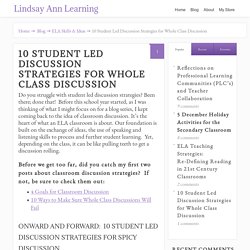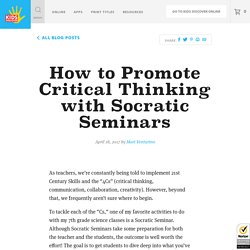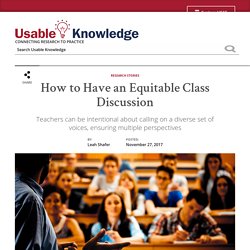

All About Asking Better Questions. Asking questions is such a basic tool of teaching, yet how many of us have ever been taught to ask good questions?

As I started researching for this post, I realized how little I actually knew about asking questions. I asked hundreds of questions a day but had zero training. I know I’m not alone! Here’s the plan: So, we’ll actually start in perhaps a strange place, which is to open with the idea of asking fewer questions as teachers and allowing more room for students to be the questioners. Mrs. Let me take you back to 1997, when my sophomore English teacher, Mrs. Why would a teacher have such a hard time getting her advanced 10th graders to ask a darn question?
Well, as one of those students, I can tell you that I had been trained to answer questions, not ask them. I pledged to ask two questions and doubt I lived up to my bargain. Who Asks Whom? So, as we dig into questioning, let’s start with wondering who asks the questions in your classroom and who gets asked. Youth Empowerment. Listening. How to make good arguments at school (and everywhere else) From as early as Grade 3 teachers start teaching children how to put across their own points of view.

It’s not about winning arguments, but ensuring kids grow up to be thoughtful and engaged citizens. These skills might come in to play at school in essay writing, in oral presentations or in debates. And whether we’re talking about making arguments for school or just in life, there are three things present in all good arguments. Read more: No, you're not entitled to your opinion 1.
Reasonability is about connecting reasons and evidence to your opinions. The first is for our own clarity of thought, so we understand how concepts and events relate to each other (or realise when they don’t). The second is so others can assess our reasons. One shortcoming in the Australian Curriculum is that it asks students to write persuasively, by using emotive language.
Read more: What's the best, most effective way to take notes? 2. 3. There are several major benefits in recognising our own fallibility. (37) 60-Second Strategies. Day 4: Troubleshooting discussions – challenges and strategies – ANU Online Coffee Courses. More Talking in Class, Please. Providing consistent, structured time for students to participate in collaborative conversations can improve the overall classroom environment because once the need to sit quietly is replaced with opportunities to discuss course content, the amount of off-topic talking declines. Both small group and whole class discussions can provide these opportunities. Small Group Discussion Recommendations Teachers can facilitate quick small group collaborative conversations during class and provide immediate opportunities for students to verbally process their learning. Students often benefit from a few moments of quiet before speaking. I call this time Silent Seconds, when students spend around 10 seconds collecting their thoughts before they speak.
Edutopia. Speed Sharing – a non-threatening alternative. Student writing is often read only by the student and teacher.

Or, if it is shared, the student may be asked to read to the entire class, which is a nerve-racking experience for many pupils. We’ve found there is a better, quick paced, non-threatening way for students to share their writing and research with each other, whether it be a hand-written paper, a word-processed then printed document, or work done on a tablet device.
This technique can be used with students aged nine or 10 through to adult learners. We call it ‘Speed Sharing’ and it has been a great success with many of our students of varying ages and grades. Speed Sharing room arrangement Three, four or five presenters-sharers are chosen to begin the process. The mechanics – rotations and every minute counts We usually allot four minutes for each sharing session. Assuming your sharing period is four minutes, at the two minute mark the teacher tells the group ‘Your time is half over—two minute warning!’. Student Led Discussion Strategies for Whole Class Discussion. Do you struggle with student led discussion strategies?

Been there; done that! Before this school year started, as I was thinking of what I might focus on for a blog series, I kept coming back to the idea of classroom discussion. It’s the heart of what an ELA classroom is about. Our foundation is built on the exchange of ideas, the use of speaking and listening skills to process and further student learning. Yet, depending on the class, it can be like pulling teeth to get a discussion rolling.
Avoiding the Pitfalls of Student Group Work. By Patrice Palmer.

How to Promote Critical Thinking with Socratic Seminars - Kids Discover. As teachers, we’re constantly being told to implement 21st Century Skills and the “4Cs” (critical thinking, communication, collaboration, creativity).

However, beyond that, we frequently aren’t sure where to begin. To tackle each of the “Cs,” one of my favorite activities to do with my 7th grade science classes is a Socratic Seminar. Although Socratic Seminars take some preparation for both the teacher and the students, the outcome is well worth the effort! The goal is to get students to dive deep into what you’ve covered in class and think critically about the topic at hand. A Socratic Seminar is a student-led discussion where part of the class is in an inner circle speaking, and the other part of the class is in an outer circle observing. How to Have an Equitable Class Discussion. These patterns can be self-perpetuating, and they can discourage learning.

Students who are called on over and over may come to view their perspectives as the right perspectives. At the same time, students who are not called on often may begin to perceive their teachers as unfair — and become even less likely to contribute. Establishing inclusive, equitable norms of participation from the start is key. "It's absolutely essential to figure out a way of managing who's speaking when, who's taking turns, in any kind of seminar discussion," says Harvard lecturer Timothy Patrick McCarthy, who teaches a course called Stories of Slavery and Freedom and who strives to make his class discussions equitable from day one.
"You don't want one or two or three or a cohort of voices to dominate the discussion. " Valuing Diverse Voices This practice helps elevate marginalized voices, and it also helps ensure that students will learn from classmates and peers of different backgrounds. Student Led Discussion Strategies for Whole Class Discussion.